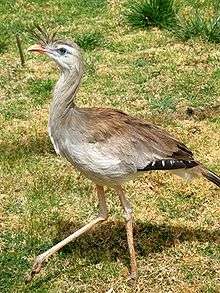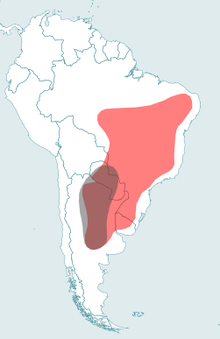Seriema
| Seriemas Temporal range: 16–0 Ma Early Miocene – Recent | |
|---|---|
 | |
| Red-legged seriema (Cariama cristata) | |
| Scientific classification | |
| Kingdom: | Animalia |
| Phylum: | Chordata |
| Class: | Aves |
| Order: | Cariamiformes |
| Superfamily: | Cariamoidea Bonaparte, 1853 |
| Family: | Cariamidae Bonaparte, 1853 |
| Genera | |
 | |
| Ranges of red-legged (red) and black-legged (black) seriemas | |
The seriemas are the sole living members of the small bird family Cariamidae, which is also the only surviving lineage of the order Cariamae. Once believed to be related to cranes, they have been placed near the falcons, parrots and passerines, as well as the extinct terror birds.[1][2] The seriemas are large, long-legged territorial birds that range from 70 to 90 cm. They live in grasslands, savanna, dry woodland and open forests of Brazil, Bolivia, Argentina, Paraguay and Uruguay. There are two species of seriemas, the red-legged seriema (Cariama cristata) and the black-legged seriema (Chunga burmeisteri).[3] Names for these birds in the Tupian languages are variously spelled as siriema, sariama, and çariama, and mean "crested".[4]
Description
Both species are around 90 cm (35 in) long (the red-legged seriema is slightly bigger than the black-legged, with 90 and 70–85 cm respectively). They forage on foot and run from danger rather than fly (though they can fly for short distances, and they roost in trees). They have long legs, necks, and tails, but only short wings, reflecting their way of life. They are among the largest ground-dwelling birds endemic of the Neotropics (only behind rheas).[3]
They are brownish birds with short bills and erectile crests, found on fairly dry open country, the red-legged seriema preferring grasslands and the black-legged seriema preferring scrub and open woodland. They give loud, yelping calls and are often heard before they are seen. They have sharp claws, with an extensible and very curved second toe claw.[3]
 The black-legged seriema (Chunga burmeisteri) is smaller and has a more restricted distribution.
The black-legged seriema (Chunga burmeisteri) is smaller and has a more restricted distribution._-_Weltvogelpark_Walsrode_2013-01.jpg) The frontal crest of the red-legged seriema (Cariama cristata) is unique among Neotropical birds.
The frontal crest of the red-legged seriema (Cariama cristata) is unique among Neotropical birds. The seriemas have short wings and rarely take flight.
The seriemas have short wings and rarely take flight.
Behaviour and ecology
Ecologically, the seriema is the South American counterpart of the secretary bird. They feed on insects, snakes, lizards, frogs, young birds, and rodents, with small amounts of plant food (including maize and beans). They often associate with grazing livestock, probably to take insects the animals disturb. When seriemas catch small reptiles, they beat the prey on the ground (Redford and Peters 1986) or throw it at a hard surface to break resistance and also the bones. If the prey is too large to swallow whole, it will be ripped into smaller pieces with a sickle claw by holding the prey in the beak and tearing it apart with the claw.
In contact with humans, the seriemas are always suspicious and if they feel threatened by them, usually spread its wings and face them. They walk in pairs or small groups. Although perfectly capable of flying, they prefer to spend most of their time on land. They only take flight when necessary, so as to escape a predator. Overnight they take shelter in the treetops, where they also build their nests.
Seriemas build bulky stick nests. They lay two or three white or buff eggs sparsely spotted with brown and purple. The female does most of the incubation, which lasts from 24 to 30 days. Hatchlings are downy but stay in the nest for about two weeks; then they jump down and follow both parents. They reach full maturity at the age of four to five months.
Classification

There are two living species of seriemas. The red-legged seriema, or crested cariama (Cariama cristata) is found from eastern Brazil, to central Argentina. It is bigger and nests on the ground or in bushes or trees up to 3 m (9.8 ft) above the ground. The black-legged seriema (Chunga burmeisteri) is found in northwest Argentina and Paraguay. It nests in trees.
These birds are thought to be the closest living relatives of a group of gigantic (up to 10 ft or 3.0 m tall) carnivorous "terror birds", the phorusrhacids, which are known from fossils from South and North America.[5][6] Several other related groups, such as the idiornithids and bathornithids were part of Palaeogene faunas in North America and Europe and possibly elsewhere too.[5][6] However, the fossil record of the seriemas themselves is poor, with two prehistoric species, Chunga incerta from the Pliocene of Argentina and Noriegavis santacrucensis from the Miocene of Argentina, having been described to date.[7] Some of the fossils from the Eocene fauna of the Messel Pit (i.e. Salimia and Idiornis) have also been suggested to be seriemas,[8] as has the massive predatory Paracrax from the Oligocene of North America,[7] though their status remains uncertain.
References
- ↑ Hackett, S. J. et al. (2008) A Phylogenomic Study of Birds Reveals Their Evolutionary History. Science 320(5884):1763–1768 10.1126/science.1157704
- ↑ Jarvis, E. D.; Mirarab, S.; Aberer, A. J.; Li, B.; Houde, P.; Li, C.; Ho, S. Y. W.; Faircloth, B. C.; Nabholz, B.; Howard, J. T.; Suh, A.; Weber, C. C.; Da Fonseca, R. R.; Li, J.; Zhang, F.; Li, H.; Zhou, L.; Narula, N.; Liu, L.; Ganapathy, G.; Boussau, B.; Bayzid, M. S.; Zavidovych, V.; Subramanian, S.; Gabaldon, T.; Capella-Gutierrez, S.; Huerta-Cepas, J.; Rekepalli, B.; Munch, K.; et al. (2014). "Whole-genome analyses resolve early branches in the tree of life of modern birds" (PDF). Science. 346 (6215): 1320–1331. doi:10.1126/science.1253451. PMC 4405904
 . PMID 25504713.
. PMID 25504713. - 1 2 3 del Hoyo, J. Elliott, A. & Sargatal, J. (editors). (1996) Handbook of the Birds of the World. Volume 3: Hoatzin to Auks. Lynx Edicions. ISBN 84-87334-20-2
- ↑ New Shorter Oxford English Dictionary
- 1 2 Naish, Darren (2006-10-27). "Terror birds". Darren Naish: Tetrapod Zoology. Retrieved 2008-03-29.
- 1 2 Alvarenga, H. M. F.; Höfling, E. (2003). "Systematic Revision of the Phorusrhacidae (Aves: Ralliformes)" (PDF). Papéis Avulsos de Zoologia. São Paulo: Museum of Zoology of the University of São Paulo. 43 (4): 55–91. doi:10.1590/S0031-10492003000400001. Retrieved 2008-03-29.
- 1 2 Mayr, G., & Noriega, J. I. A well-preserved partial skeleton of the poorly known early Miocene seriema Noriegavis santacrucensis (Aves, Cariamidae).
- ↑ Morlo, M & al. (2004): An annotated taxonomic list of the Middle Eocene (MP 11) Vertebrata of Messel. Courier Forschingsinstitut Senckenberg 252, pp 95-108.
External links
| Wikimedia Commons has media related to Cariama cristata. |
- Seriema videos on the Internet Bird Collection